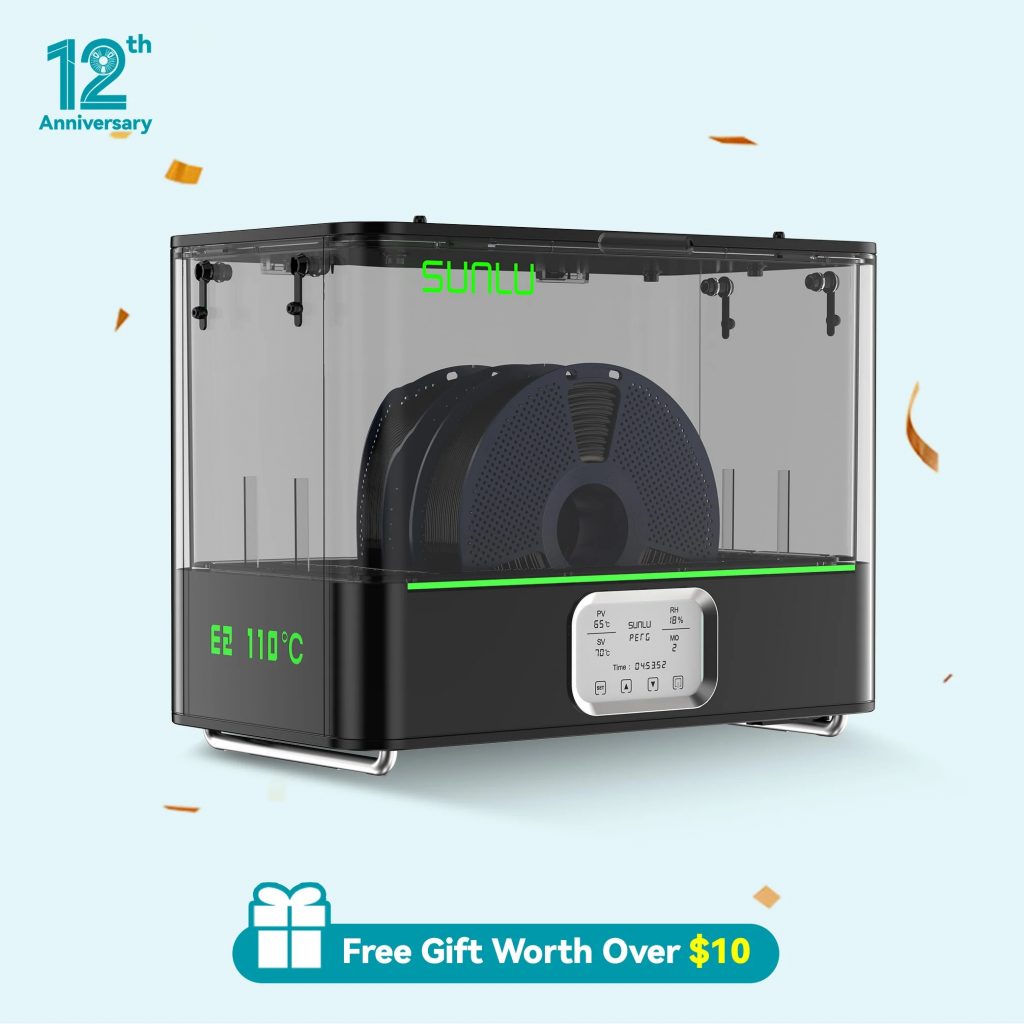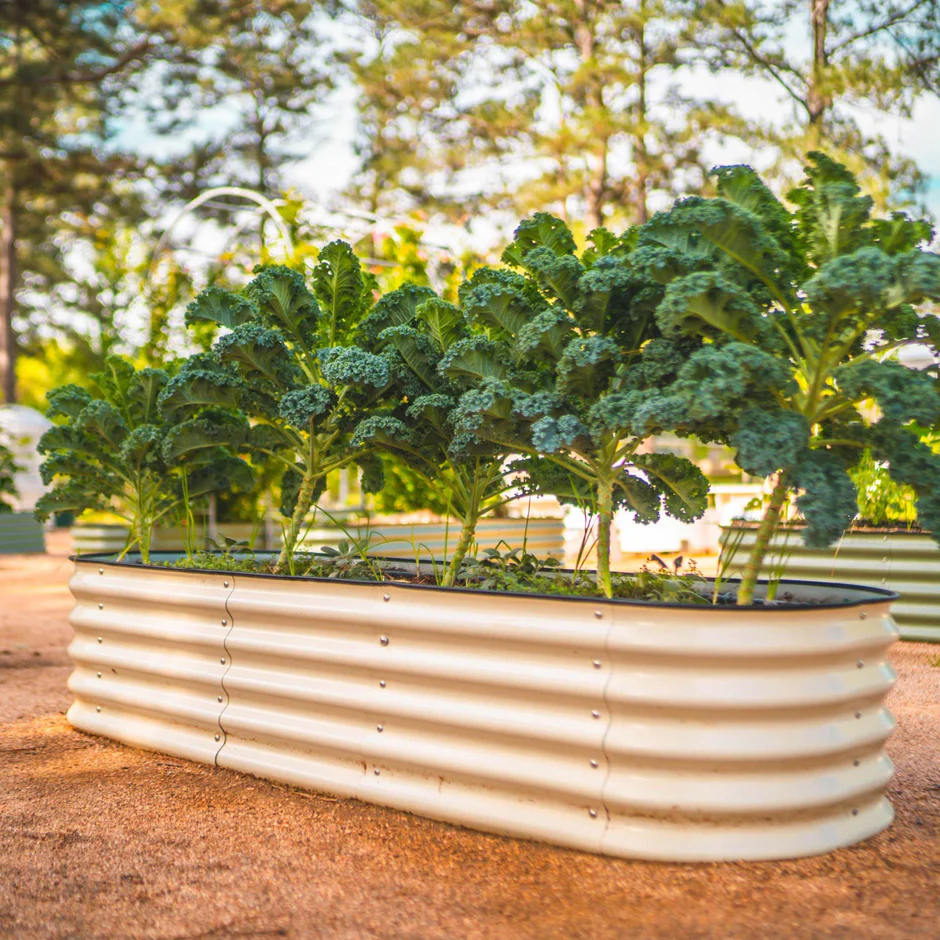
Quality filament, such as SUNLU filament, is essential for successful 3D printing. However, many makers overlook a hidden threat to print quality: moisture absorption. Even the best filament like SUNLU can become problematic when exposed to humidity.
Think your prints are failing because of incorrect settings? The real issue might be right in front of you. Moisture-contaminated filament, including SUNLU filament, can cause a range of printing problems:
- Weak layer adhesion
- Inconsistent extrusion
- Surface defects
- Failed prints
- Potential printer damage
These problems occur when water molecules penetrate the structure of your filament, like SUNLU. When heated in your printer’s hot end, this moisture turns into steam, disrupting the smooth flow of material and ruining your print quality.
Are you experiencing stringing, hearing popping sounds, or getting brittle prints? It’s possible that your filament is wet. The SUNLU Filament Dryer offers a professional-grade solution to restore your filament’s optimal printing condition and protect your investment in high-quality materials.
Understanding Moisture Problems in 3D Printing Filament
3D printing filaments are hygroscopic materials – they naturally absorb moisture from the surrounding air. This property affects different filament types with varying intensity:
- Nylon – Extremely hygroscopic, can absorb up to 10% of its weight in moisture
- TPU/TPE – Highly susceptible to moisture absorption
- PETG – Moderately affected by humidity
- PLA – Less hygroscopic but still vulnerable
- ABS – Relatively moisture-resistant but not immune
When filaments absorb water molecules, they undergo chemical changes that compromise their printing performance. The absorbed moisture breaks down the polymer chains through a process called hydrolysis. This degradation happens at the molecular level, weakening the material’s structure even before it reaches your printer’s hot end.
During printing, the trapped moisture turns to steam at the hot end (190-260°C), causing rapid expansion. This steam expansion creates microscopic voids in the plastic as it’s being extruded, leading to:
- Reduced material strength
- Inconsistent flow rates
- Degraded layer adhesion
- Compromised dimensional accuracy
- Permanent damage to the filament’s molecular structure
The severity of moisture-related issues depends on exposure time, ambient humidity levels, and storage conditions. Some filaments can become unprintable within hours of exposure to humid air, while others may take days or weeks to show noticeable degradation.
5 Clear Signs Your Filament is Wet and How They Impact Your Prints
Identifying wet filament early can save you hours of troubleshooting and failed prints. Let’s examine the first telltale sign that moisture has compromised your filament quality.
1. Popping or Hissing Sounds During Printing
That distinctive pop-pop-pop sound during printing isn’t just annoying – it’s a clear warning sign of moisture-laden filament. When wet filament enters your hot nozzle, the trapped water molecules rapidly heat up and turn to steam, creating tiny explosions that produce these audible sounds.
What causes the popping sound?
- Water molecules trapped in the filament instantly vaporize at printing temperatures (180-250°C)
- Steam expands rapidly, creating micro-explosions inside the nozzle
- These explosions force small amounts of molten plastic outward
- The rapid pressure release generates the characteristic popping noise
Impact on print quality:
- Small gaps or holes in the printed layers
- Inconsistent extrusion flow
- Potential for nozzle blockages
- Reduced structural integrity of the final print
The severity and frequency of these popping sounds directly correlate with the moisture content in your filament. A few occasional pops might indicate minor moisture absorption, while constant popping signals severely compromised filament that requires immediate drying.
Listen for these specific sounds:
- Sharp, distinct popping noises
- Crackling or sizzling during extrusion
- Irregular hissing when filament exits the nozzle
- Unusual extruder sounds that differ from normal printing
These audible cues often appear before visual print defects become apparent, making them an early warning system for moisture-related issues. Catching this problem early can prevent wasted material and failed prints.
2. Excessive Stringing and Oozing on Prints
Stringing and oozing are clear signs that your filament has absorbed moisture. These problems appear as thin strands of plastic connecting different parts of your print, creating a web-like look that ruins surface quality and dimensional accuracy.
Wet filament creates excess steam pressure inside the nozzle, forcing material out even when retraction is active. This leads to:
- Unwanted plastic strings between print features
- Blobs and zits on outer walls
- Messy bridging and overhangs
- Poor detail definition on small features
The severity of stringing varies with different materials:
PETG shows extreme cobweb-like stringing
PLA develops shorter, thicker strings
Nylon exhibits heavy oozing and blobbing
These defects can’t be fixed through slicer settings alone. The moisture trapped in your filament transforms into steam during printing, expanding the plastic and causing uncontrolled material flow. Each strand of unwanted plastic represents wasted material and hours of post-processing cleanup time.
3. Poor Surface Finish with Bubbles or Rough Textures
Moisture-laden filament creates distinctive surface imperfections that can ruin the aesthetic appeal of your prints. When wet filament passes through the hot nozzle, trapped water molecules instantly vaporize, creating tiny steam bubbles that burst through the molten plastic. These bursts leave behind telltale surface defects:
- Small crater-like depressions across print surfaces
- Raised bumps and blisters on layer walls
- Uneven, rough textures resembling orange peel
- Visible air pockets trapped between layers
The severity of these surface defects varies with moisture content and printing temperature. Higher temperatures amplify the problem as water vaporizes more violently. Nylon and PETG users often notice these issues first, as these materials are particularly susceptible to moisture absorption.
A magnified inspection of affected prints reveals a pattern of microscopic holes where steam escaped during extrusion. These imperfections compromise both the visual quality and structural integrity of printed parts, making surface finish problems one of the most reliable indicators of wet filament.
4. Inconsistent Extrusion Leading to Weak or Incomplete Layers
Filament with moisture content causes significant fluctuations in extrusion rates during printing. When water molecules trapped inside the filament turn into steam at high temperatures, they disrupt the smooth flow of material through the nozzle. This leads to:
- Gaps between layers – Areas where insufficient material was deposited
- Inconsistent layer thickness – Some layers appear thicker while others are thinner
- Weak bonding – Poor adhesion between layers due to interrupted material flow
- Structural instability – Parts that break easily under minimal stress
The uneven extrusion pattern creates internal stresses and voids within the printed object. These flaws weaken the mechanical properties of your prints, rendering them unsuitable for functional parts or prototypes requiring specific strength characteristics.
A simple test reveals this issue: Try bending or applying pressure to your print. If it breaks easily along layer lines or exhibits unusual brittleness, moisture-compromised extrusion is likely the cause. Parts printed with properly dried filament maintain consistent layer adhesion and demonstrate superior strength in all directions.
5. Jamming or Clogging of the Extruder Nozzle
Wet filament can create severe blockages in your extruder nozzle, leading to complete print failures and potential hardware damage. When moisture-laden filament enters the hot end, it rapidly turns to steam, creating pressure buildup inside the nozzle. This steam explosion can force melted plastic into unwanted areas of your hot end assembly.
Common signs of moisture-related clogs include:
- Filament grinding at the extruder gear
- No material flow despite motor movement
- Irregular extrusion patterns
- Sudden stops in material flow mid-print
These clogs often require complete hot end disassembly for cleaning, risking damage to delicate components. The steam pressure can also cause molten plastic to back up into the heat break and create “heat creep” issues that persist even after changing to dry filament.
The risk of permanent hardware damage makes nozzle clogs one of the most serious consequences of printing with wet filament. Regular cleaning and maintenance become necessary, increasing printer downtime and reducing productivity.
Introducing the SUNLU Filament Dryer: The Ultimate Solution for Wet Filament Problems
The SUNLU FilaDryer S2 is a groundbreaking device designed specifically for drying 3D printing filament. It offers an effective and dependable solution to combat moisture-related issues, ensuring top-notch print quality every time.
What Makes SUNLU Stand Out?
1. Fast Heating Technology
- Uses advanced PTC heating technology
- Reaches optimal drying temperatures in minutes
- Distributes heat evenly to prevent filament deformation
2. Intelligent Temperature Control
- Allows users to set specific temperatures for different filament types
- Offers a temperature range of 35°C to 75°C
- Features a digital display for precise monitoring
3. Efficient Drying with Hot Air Circulation
- Employs 360° hot air circulation for uniform drying
- Removes moisture efficiently from the filament
- Reduces drying time compared to traditional methods
The SUNLU FilaDryer S2 can accommodate standard 1kg spools and has a transparent cover that lets users keep an eye on their filament while it dries. Additionally, it has a built-in humidity sensor that provides real-time feedback on moisture levels.
How Does SUNLU Perform Compared to Traditional Methods?
Conventional Oven Method:
- Risk of temperature fluctuations
- Uneven heating
- Potential damage to filament
- No control over humidity levels
DIY Solutions:
- Limited ability to control temperature
- Inconsistent results in drying
- No monitoring of moisture content
- Time-consuming setup process
SUNLU FilaDryer S2:
- Precise regulation of temperature
- Designed specifically for caring for filament
- Active removal of moisture during drying
- Safe and controlled environment for drying
Unlike traditional methods that rely on guesswork, the SUNLU system’s dedicated design takes the uncertainty out of the drying process. Users can set specific drying cycles based on the type of filament and its moisture content using the programmable timer function. Its compact size makes it a space-efficient addition to any printing setup, and the rolling spool mechanism allows for direct printing from the dryer – an especially valuable feature for materials sensitive to moisture like Nylon or TPU.
For those looking to enhance their 3D printing experience, it’s worth noting that SUNLU offers a wide selection of affordable filaments such as PLA and PETG, along with high-quality resins and printers. Their products provide professional-grade results without straining your budget.
Best Practices for Filament Storage to Maintain Dryness After Using the SUNLU Filament Dryer
Your SUNLU Filament Dryer effectively removes moisture from your filaments – but proper storage practices are crucial to maintain these optimal conditions. Here’s how to protect your dried filaments from moisture reabsorption:
Airtight Storage Solutions
- Use containers with rubber gaskets or silicone seals
- Consider vacuum-sealed bags for long-term storage
- Store multiple spools in larger airtight totes with secure clasps
- Check container seals regularly for signs of wear or damage
Effective Use of Desiccants
- Place 2-3 silica gel packets per spool
- Replace desiccants every 3-6 months
- Use color-indicating desiccants to monitor saturation levels
- Regenerate reusable desiccants in the SUNLU dryer at 65°C
Environmental Controls
- Store containers in cool, dark locations
- Keep away from bathrooms, kitchens, or humid areas
- Monitor room humidity with a hygrometer
- Consider using a room dehumidifier in high-humidity climates
Storage Organization Tips
- Label containers with filament type and drying date
- Rotate stock to use older filaments first
- Keep partial spools separate from new ones
- Store different materials in separate containers
Quick Access Strategy
- Keep frequently used spools in the SUNLU dryer
- Transfer filaments directly from dryer to printer
- Return unused filament to storage immediately
- Use quick-seal containers for active projects
These storage practices complement your SUNLU Filament Dryer’s performance, ensuring consistently high-quality prints and extended filament life.
Fixing Brittle PLA and Other Common Filament Issues with Proper Drying Techniques
Brittle PLA is a major problem for 3D printing enthusiasts. When moisture gets into PLA filament, it causes a chemical reaction called hydrolysis, which breaks down the molecular chains that make PLA flexible and strong. As a result, the once-flexible filament becomes brittle and is likely to snap or break during printing.
Signs of Moisture-Induced Brittleness:
- Filament snaps with minimal bending
- Frequent breaks during feeding
- Increased print failures due to filament breakage
- Rough, inconsistent extrusion
The SUNLU Filament Dryer restores PLA’s optimal physical properties through controlled heat application. At temperatures between 45-50°C (113-122°F), the dryer removes absorbed moisture without damaging the filament structure. This process reestablishes the material’s natural flexibility and printability.
Drying Duration Guidelines for Brittle PLA:
- Light moisture exposure: 4-6 hours
- Severe cases: 8-12 hours
- Maintenance drying: 2-3 hours before printing
The restoration process works differently for various filament types:
- PLA: Becomes flexible again at 45-50°C
- PETG: Regains strength at 65°C
- Nylon: Requires higher temperatures around 70-80°C
Regular drying cycles prevent brittleness from developing and maintain consistent print quality. The SUNLU dryer’s precise temperature control ensures safe and effective moisture removal without risking thermal damage to your valuable filaments.
Conclusion
Bad prints waste time, materials, and cause endless frustration. Signs of wet filament, such as popping sounds and weak layers, clearly indicate the need for proper filament care.
A dedicated filament dryer like SUNLU provides the controlled environment needed for reliable 3D printing results. This purpose-built solution eliminates guesswork and risks associated with DIY methods or household ovens.
The path to consistently successful prints requires:
- Regular monitoring of filament condition
- Proactive drying with proper equipment
- Smart storage practices using airtight containers
- Quick intervention when moisture signs appear
Don’t let wet filament ruin your projects. The SUNLU Filament Dryer offers a professional-grade solution that pays for itself through saved materials and superior print quality. Make filament drying an essential part of your 3D printing workflow – your prints will thank you with crisp details, strong layers, and professional results.

